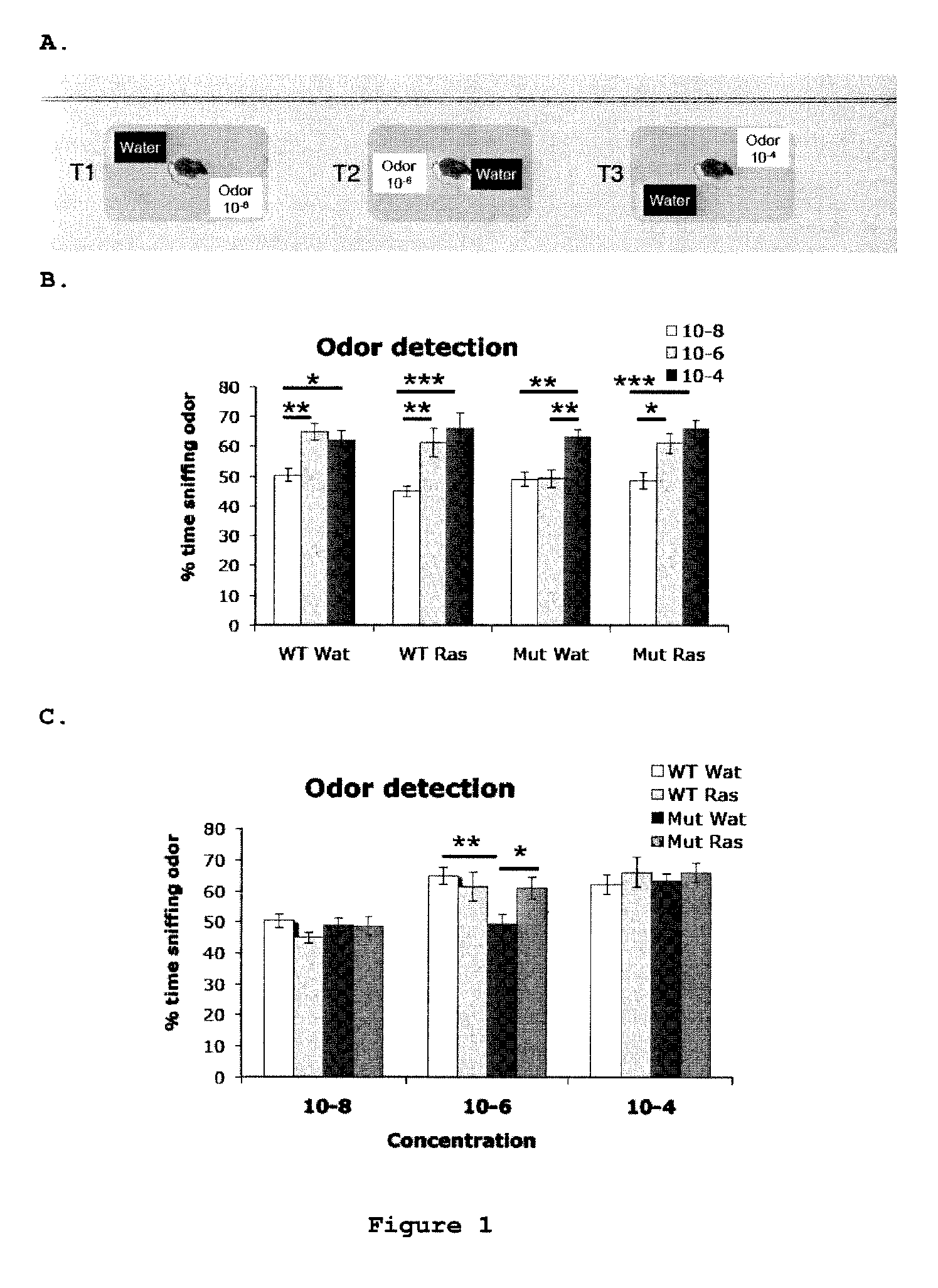Use of rasagiline for the treatment of olfactory dysfunction
a technology of rasagiline and olfactory function, which is applied in the direction of biocide, drug composition, nervous disorder, etc., can solve the problems of adversely affecting the health of patients, reduce the rate of olfactory dysfunction progression, inhibit the loss of olfactory function, and reduce the rate of olfactory dysfunction. the effect of olfactory function loss
- Summary
- Abstract
- Description
- Claims
- Application Information
AI Technical Summary
Benefits of technology
Problems solved by technology
Method used
Image
Examples
example 1
Odor Detection Threshold Determination
[0070]This experiment was designed to determine whether rasagiline had positive effect on odor detection threshold of olfactory challenged animals (FIG. 1A). Odor detection threshold is the lowest concentration (dilution 10−8; 10−6; 10−4 in the water) at which mice are able to detect a novel odor. Upon detection of a novel odor, mice will spend more time sniffing it. The detection threshold was measured as percentage of time sniffing novel odor out of total time of sniffing.
Results:
[0071]The results of the experiment are summarized in tables 1a-1d. The analysis was performed by 2-way ANOVA followed by Bonferroni post-hoc test (*p<0.05, **p<0.01, ***p<0.001).
[0072]
TABLE 1aOdor detection threshold of WT untreated miceTreatment Group% time sniffing odor(n = 10)at concentration:MiceGenotypeTreatment10−810−610−42WTWater48.351.461.46WTWater48.174.574.613WTWater51.363.266.217WTWater35.877.768.120WTWater59.060.865.524WTWater45.767.854.626WTWater52.268.7...
example 2
Short-Term Olfactory Memory
[0078]This experiment was designed to assess the effect of rasagiline on the capability of the mutant animals to remember a novel odor during a short time interval of 1 min, 1 min 30 s or 2 min (FIG. 2A). The underlying principle was that if mice would spend less time sniffing the odor at T2 (second exposure to the odor) their short term olfactory memory is intact. The testing parameter was percentage of time of sniffing at T2, calculated as time of sniffing at T2 out of total time of sniffing at T1 (first exposure) & T2.
Results:
[0079]The results of the experiment are summarized in tables 2a-2d. The analysis was performed by 2-way ANOVA followed by Bonferroni post-hoc, or by a non parametric test, Kruskal-Wallis, when the normal distribution failed.
[0080]
TABLE 2aShort-term olfactory memory of WT untreated miceTreatment Group% time sniffing during(n = 10)T2 after interval:MiceGenotypeTreatment1 Min1.5 min2 min2-2 WTWater35.425.937.12-6 WTWater36.620.119.62-...
example 3
Social Odor Discrimination
[0087]This experiment was designed to assess effect of rasagiline on the capability of the mice to discriminate between a familiar social odor (F) and a novel social odor (N) (FIG. 3A). Mice capable of discriminating between the odors would spend more time sniffing the new odor. The experiment was further subdivided into two levels of odor intensity:
Light intensity: two days of odor impregnation
Strong intensity: seven days of odor impregnation
The testing parameter was percentage of time of sniffing novel odor out of total time of sniffing.
Results:
1. Discrimination of Light Social Odors:
[0088]The results of the experiment are summarized in tables 3a-3d. The analysis was performed a non parametric test, Kruskal-Wallis, and Mann-Whitney test was used as post-hoc (***p<0.001).
[0089]
TABLE 3aDiscrimination of light social odors by WT untreated miceTimeTimeTotalMiceSniffingSniffingtime% time(n = 21)GenotypeTreatmentFNsniffingsniffing N1-2WTWater2.97.310.271.41-6WT...
PUM
| Property | Measurement | Unit |
|---|---|---|
| time | aaaaa | aaaaa |
| time | aaaaa | aaaaa |
| homogeneity | aaaaa | aaaaa |
Abstract
Description
Claims
Application Information
 Login to View More
Login to View More - R&D
- Intellectual Property
- Life Sciences
- Materials
- Tech Scout
- Unparalleled Data Quality
- Higher Quality Content
- 60% Fewer Hallucinations
Browse by: Latest US Patents, China's latest patents, Technical Efficacy Thesaurus, Application Domain, Technology Topic, Popular Technical Reports.
© 2025 PatSnap. All rights reserved.Legal|Privacy policy|Modern Slavery Act Transparency Statement|Sitemap|About US| Contact US: help@patsnap.com



